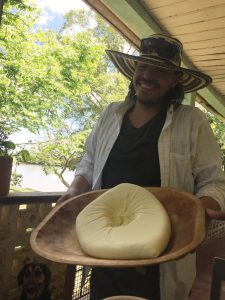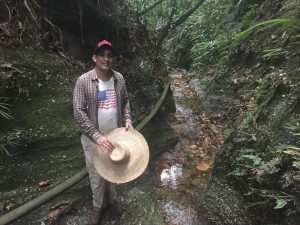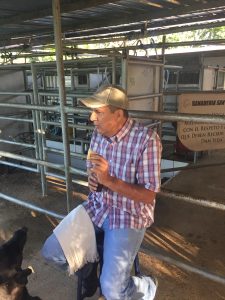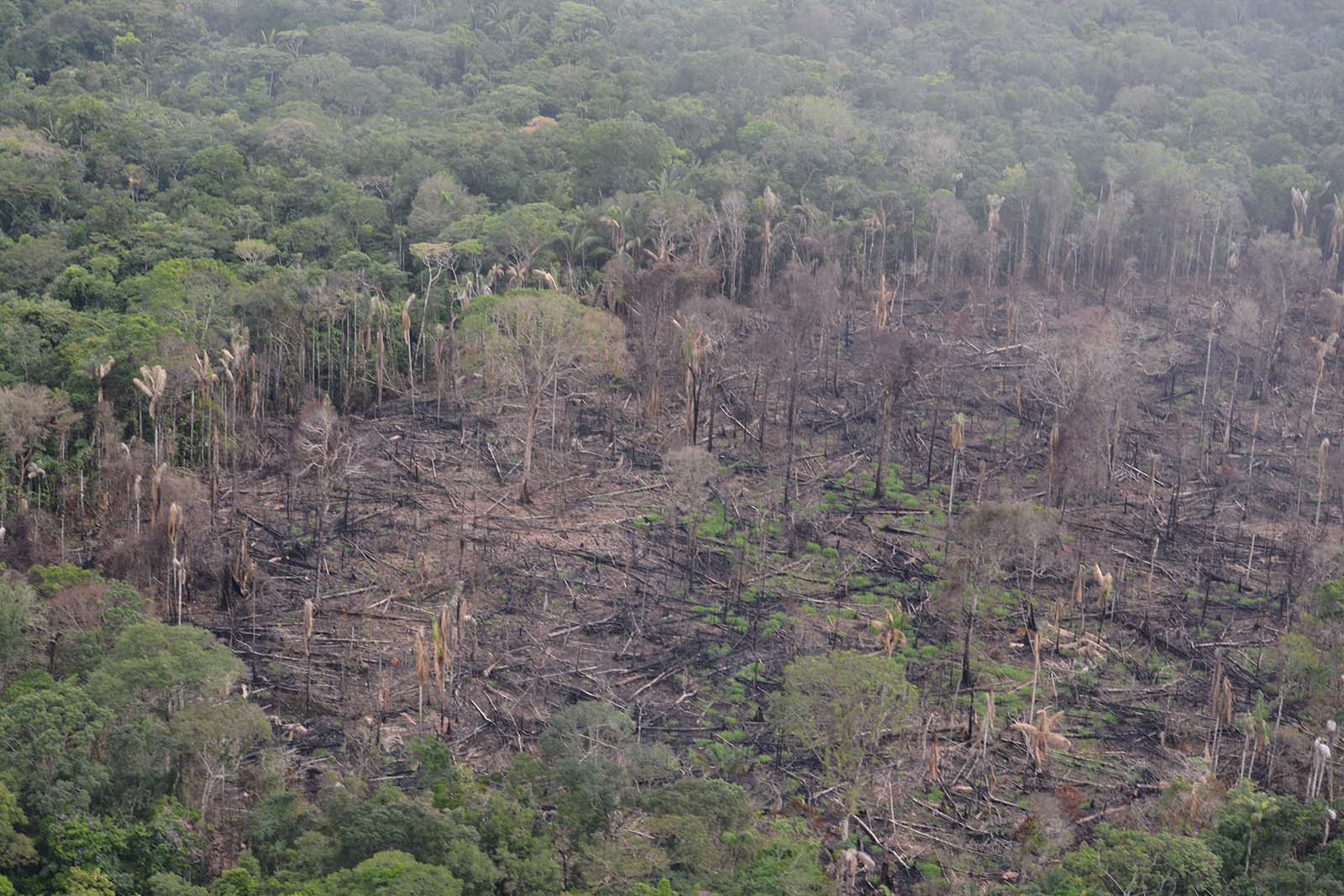
Deforestation of the Colombian Amazon rainforest by the slash and burn method in Parque Chiribiquete, San Jose de Gauviare, April 2018. Photo: Rodrigo Botero
Deforestation in the Amazon has reached a critical point – if action is not taken now, the eco-systems will not recover.
Colombia is losing about half a football field of forest cover per minute, affecting climate and levels of both CO2 and water, according to Mauricio Cote, a climate change specialist with Fundación Natura, the oldest environmental non-profit organisation in Colombia.
I travelled to Florencia in Caquetá, where the Amazon forest starts, to see what is happening for myself. I went with Cote and a group of environmentalists who want to record successful case studies for a policy report that they will present to the Colombian government.
“The attack is happening in the most critical places,” Rodrigo Botero, scientist and founder of the nonprofit environmental foundation, Fundación para la Conservación y el Desarrollo Sostenible told me in an interview before I set out.
He compared the Amazon to a human body, saying: “It’s like strangling your neck. It’s putting pressure on an essential part of the body, which is what is happening to the ecosystems of this country.”
And strangling is no exaggeration. Although the Colombian government has vowed to achieve a zero percent deforestation rate by 2020, the rate is increasing.
Around 178,597 hectares (690 square miles) of forest was cleared in 2016, a 44 % increase from the year before. In 2017, Colombia’s deforestation rate increased by a further 23%. This year alone, 65.5% of the national deforestation has taken place in the Amazon.
Featured: FIMA 2018: an environment for change
Driving up and down the long and winding roads, we could see the billowing walls of smoke through the canopy of green trees – clear evidence of deforestation in action. The consequences of deforestation were evident too: we could see the erosion of the riverbanks and farmers told me that their land is no longer as fertile as it used to be.
Put simply, deforestation in the Colombian Amazon is reaching a dangerous point of no return. What is devastating is not only the rapid rate of of deforestation, but also the areas where the deforestation is taking place – in previously untouched parts of forest where the ecosystems may not recover.
Destruction
The impact of this destruction includes the loss of species – vital in the second most biodiverse country in the world. Clearing forests of trees that absorb greenhouse gases and keep soil fertile also exacerbates the effects of extreme weather scenarios such as El Niño or La Niña.
Critical areas of the forest are crucial for the cycle of water evaporation, a key element in Colombia’s climate. Although the water cycle normally creates rain and snow, with climate change it can also cause extreme drought and heavy rains—remember the 2017 mudslides in Mocoa and the 2018 floods?
Almost two years after the peace agreement and with a new government in power, it is a pivotal time for the country and its environment. The thorny questions of how to protect Colombia’s fragile ecosystems, protect rural communities and at the same time develop agriculture and industry have been making headlines all year.
In April a group of young Colombians won a lawsuit against the president, fighting for the rights for the Amazon river. Less positive was a recent story that officials and paramilitaries were threatening farmers into selling land far below market value, adding to displacement of Colombians and to the rate of deforestation.
So, what is causing deforestation and why is it increasing so fast? Both the environmentalists I spoke to told me that extensive cattle ranching, appropriation of lands, illegal crops, and the construction of highways all play their parts.
Another issue is the impact of the withdrawal of former guerilla group, the FARC. Coca cultivation does contribute to deforestation, but the rate of deforestation was lower in FARC-controlled territories as the guerillas made those areas inaccessible for state activities as well as big business.
Now local politicians, mining companies, guerilla groups, drug traffickers, and cattle ranchers are all active in areas outside the reaches of the central government — an area with little control.
While many blame deforestation on illegal activities, it is clear that there is a lot of profit made from legal activities as well. Cote explained that large industries and companies with disposable capital are some of the principal actors accelerating the rate of deforestation.
“There is a lot of money behind deforestation,” he said. “The (large industries) cut trees at a rate impossible for the average farmer.”
Cote explained that people and companies also slash and burn the land to mine, produce wood, and plant crops to sell – such as palm oil or even coca. “New actors are coming in: settlers, farmers, international conglomerates with huge financial power to buy up land and sell them,” he said.
It’s a voracious land grab, and the consequences of this situation are serious.The forest is literally burning.
“Despicable,” said Daniela Espejo, project manager with Fundación Natura who was in the car with me as we watched a thick cloud of smoke rise from the green canopies.
Taking a boat down the Caguán river, we didn’t see the lush rainforest I had expected. Instead, we saw miles of flat grassland lining the widening river. Even more alarming, instead of a beach or a slight incline from land to water, the sides of the river look as if someone took a knife and sliced the banks like a piece of cake. A farmer explained to me that the riverbanks are eroding because there aren’t any trees to retain the water.
Hitting out
So what can be done to bring deforestation under control? The government has committed to reduce the rate of destruction, but it is also pursuing an expansive 4G infrastructure project and working to attract international investment.
Some, like Botero, feel that the environment is taking a back seat to other sectors. The MinAmbiente has the second lowest budget of all the government sectors.
“The Earth has to stop taking last place,” Botero said.
But Cote stressed that the government already has a lot of tools at its disposal, and organisations like the IDEAM can effect change. He highlighted international pressure and targets such as the Tropical Forest Alliance 2020. He was also insistent that individuals could help to tackle deforestation through activities such as verifying that the products they use are not contributing to deforestation (Carbon Disclosure Project) and pursuing eco-tourism.
Both Botero and Cote were extremely critical of the Marginal de la Selva highway highway which is now on hold. Going through the area that we were visiting in Florencia, it would have opened a trade route from Ecuador to Venezuela, bypassing the Andes.
This $1 billion infrastructure project was put on hold following the enormous outcry from environmentalists, fearing catastrophic environmental repercussions if the highway were to be constructed. Nonetheless, according to Cote, illegal and legal highways continue to be built by the all too common slash and burn method.
“There are many people interested in taking land to sell it. For example, take the highway that was being built across the Amazon. If you have land in that area, you could make a lot of money,” Cote said.
While stopping the development of the highway was a small victory, the bigger picture is bleak and it will require a concerted effort from local and state authorities, NGOs and individuals to reverse the trend.
“We are not only arriving at the most environmentally sensitive areas with the least amount of resistance, but we have also began to invade the territories of highly vulnerable indigenous communities,” Botero said.
Specifically, development of the Amazon has reached Chiribiquete park in Guaviare, and the reserves Nukak Maku and Yaguará II, which ecologically connect La Serranía de la Macarena and Chiribiquete.
The consequences of this are stark. “If you touch [this land] the possibility of recovery could take thousands of years,” concludes Botero.
Finquero Stories
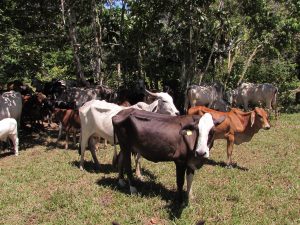
Shade from the trees decreases the stress on the cows and also helps regenerate the Amazons
With the lack of regulatory oversight in the far reaches of the Colombian Amazon, some local farmers and cattle ranchers have taken matters into their own hands.
A new generation of cattle ranchers are not only converting some of their land into wildlife reserves, and thus increasing the amount of tree cover, but they are also changing the way they raise their cattle.
They have begun to incorporate silvopastoral systems, letting trees and plants grow on their pastures. This gives shade to cows and provides a way to restore degraded soil, store carbon and increase biodiversity. They are a part of the cattle ranch union, Committee de Ganaderos del Caquetá, and are the first producers of zero-deforestation dairy products such as cheese and arequipe.
Their anti-deforestation cheese is even being used in Bogotá-based restaurant chain Sipote Burrito.
Felipe Eslava, owner of Las Esmeraldas farm in Caquetá
|
Julian García, co-owner of Las Juntas Farm
|
Antonio Ricardo, owner of San Nicolás Farm
|

